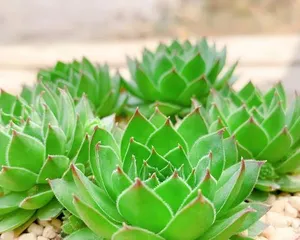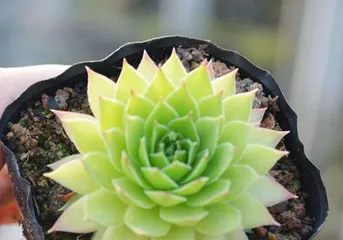The Succulent Guanyin Lotus is a highly ornamental succulent plant that has been deeply loved by gardening enthusiasts in recent years. It not only beautifies the environment but also brings a sense of peace and comfort to people. However, how to properly care for the Succulent Guanyin Lotus? The following will provide a detailed introduction to the cultivation methods and precautions for the Succulent Guanyin Lotus.

1. Understanding the Varieties and Characteristics of the Succulent Guanyin Lotus
The Succulent Guanyin Lotus belongs to the Crassulaceae family and is mainly distributed in regions such as South America, Africa, and Australia. Depending on different growth environments and habits, it can be divided into different varieties, such as "maobian" (hairy-edged), "xihan" (drought-loving), and "jinbian" (golden-edged). The characteristics of the Succulent Guanyin Lotus are its thick leaves, vibrant colors, rich flower colors, and its tolerance to drought and cold.
2. Preparing the Cultivation Site and Soil
The Succulent Guanyin Lotus prefers a sunny, well-ventilated, and dry environment. Therefore, it is suitable to choose a site with sufficient light and good drainage for cultivation. In terms of soil, a mixed soil combining materials like quartz sand, perlite, and leaf mold can be selected to ensure the soil texture is appropriate.

3. Proper Watering
The Succulent Guanyin Lotus is a water-saving plant and does not require much water, but it should not be left in a state of drought for a long time. Generally, watering once a week is sufficient for the Succulent Guanyin Lotus, but care should be taken not to overwater. Especially during the hot summer months, the frequency of watering needs to be increased, but it should be avoided during the harshest part of the midday sun to prevent scorching the plant.
4. Pay Attention to Fertilization
The Succulent Guanyin Lotus does not require frequent fertilization, but nutritional balance should be maintained. Typically, apply organic fertilizer or diluted fertilizer solution once every 2-3 months to meet its growth needs.
5. Timely Pruning
The Succulent Guanyin Lotus grows relatively slowly, but it also requires timely pruning. Especially in spring and autumn, withered leaves and branches should be pruned in a timely manner to promote its metabolism and maintain a neat appearance.

6. Pest and Disease Control
The Succulent Guanyin Lotus is relatively resistant to pests and diseases, but attention should be paid to their prevention and control. During the cultivation process, if pests are found, they can be dealt with by manual removal or spraying insecticides.
7. Mastering Transplanting Techniques
The best time to transplant the Succulent Guanyin Lotus is in spring and autumn; try to avoid transplanting in summer and winter. When transplanting, care should be taken to protect the plant's root system to ensure it can recover and grow quickly after transplantation.
8. Preventing Excessive Sun Exposure
The Succulent Guanyin Lotus likes a sunny environment but also needs to avoid excessive sun exposure. During the hot summer months, shading measures should be taken to prevent direct sunlight from scorching the leaves.
9. Proper Pruning of Stems
The stems of the Succulent Guanyin Lotus grow relatively slowly, but they also require appropriate pruning. Before the stems grow new buds, they should be pruned in time to promote the growth of new branches.
10. Regularly Changing the Soil
The Succulent Guanyin Lotus absorbs nutrients from the soil during its growth process, so the soil needs to be changed regularly. Generally, changing the soil once in spring and autumn each year is sufficient.
11. Paying Attention to Water Control
The Succulent Guanyin Lotus does not like overly humid environments, so attention should be paid to water control during cultivation. If the soil is found to be too wet, it can be dealt with by using a pot with good drainage or by replacing the soil.
12. Paying Attention to Temperature Changes
The Succulent Guanyin Lotus is relatively drought-tolerant and cold-tolerant, but attention should be paid to the impact of temperature changes on its growth. During the cold winter months, the indoor temperature should not be too low to avoid affecting its normal growth.
13. Avoiding Long-Term Exposure to Air Conditioning
The Succulent Guanyin Lotus is relatively suitable for indoor cultivation, but it is also important to avoid long-term exposure to air conditioning. Air conditioning can have a drying and chilling effect on the plant, so an appropriate indoor cultivation environment should be chosen.
14. Regularly Repotting
The root system of the Succulent Guanyin Lotus also expands during its growth process, so it needs to be repotted regularly. Generally, repotting can be done in spring and autumn each year to maintain its healthy growth.
15.
The Succulent Guanyin Lotus is a highly ornamental succulent plant, but attention needs to be paid to some details in its cultivation process. By mastering the correct cultivation methods and precautions, you can easily create premium succulent plants. It is hoped that this article will be helpful to the numerous Succulent Guanyin Lotus enthusiasts.